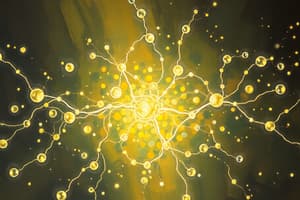Podcast
Questions and Answers
Which of the following best describes a polar molecule?
Which of the following best describes a polar molecule?
- A molecule that always contains only non-polar covalent bonds.
- A molecule in which the bond polarity vectors do not sum to zero. (correct)
- A molecule in which the bond polarity vectors sum to zero.
- A molecule that always contains only polar covalent bonds.
What determines whether a molecule with polar covalent bonds is polar or non-polar?
What determines whether a molecule with polar covalent bonds is polar or non-polar?
- The presence of ionic bonds.
- The number of lone pairs present on the central atom.
- The electronegativity of atoms present in the molecule.
- The molecular shape and the direction of bond dipoles. (correct)
In a bond dipole, what does the arrow point toward?
In a bond dipole, what does the arrow point toward?
- The more electronegative atom. (correct)
- The atom with less partial charge.
- The less electronegative atom.
- The atom with positive charge.
Which of the following molecules is non-polar, despite having polar covalent bonds?
Which of the following molecules is non-polar, despite having polar covalent bonds?
What is the primary factor that affects whether a molecule is soluble in water?
What is the primary factor that affects whether a molecule is soluble in water?
If a molecule has a trigonal pyramidal shape, and contains a Nitrogen atom, it is likely to be:
If a molecule has a trigonal pyramidal shape, and contains a Nitrogen atom, it is likely to be:
A tetrahedral molecule composed of four different atoms is typically:
A tetrahedral molecule composed of four different atoms is typically:
When will a Trigonal planar molecule be non-polar?
When will a Trigonal planar molecule be non-polar?
Flashcards
VSEPR & Molecular Polarity
VSEPR & Molecular Polarity
The shape of a molecule determines whether it is polar or non-polar - even if it has polar covalent bonds. This is because the bond dipole vectors can cancel out or add up depending on the geometry.
Polar and Non-Polar Molecules
Polar and Non-Polar Molecules
A molecule with polar covalent bonds can be either polar or non-polar depending on its shape. If the individual bond dipoles cancel out, the molecule is non-polar. If the dipoles add up, the molecule is polar.
Polar Covalent Bond
Polar Covalent Bond
A polar covalent bond occurs when electrons are shared unequally between atoms due to a difference in electronegativity, resulting in a partial positive charge (δ+) on the less electronegative atom and a partial negative charge (δ-) on the more electronegative atom.
Bond Dipole
Bond Dipole
Signup and view all the flashcards
Molecular Polarity & Bond Dipole Vectors
Molecular Polarity & Bond Dipole Vectors
Signup and view all the flashcards
CO2 as a Non-Polar Molecule
CO2 as a Non-Polar Molecule
Signup and view all the flashcards
H2O as a Polar Molecule
H2O as a Polar Molecule
Signup and view all the flashcards
Polarity and Solubility
Polarity and Solubility
Signup and view all the flashcards
Study Notes
Molecular Polarity
- VSEPR shapes determine if a molecule is polar or non-polar.
- Water (H₂O) has polar covalent bonds and is a polar molecule.
- Carbon tetrachloride (CCl₄) has polar covalent bonds but is a non-polar molecule.
- Molecular polarity does not apply to ionic bonds.
Defining Bond Polarity
- Molecular polarity is the sum of the molecule's bond polarity vectors.
- Bond polarity is determined by identifying electronegativities.
- Partial charges (δ+) and (δ−) indicate electronegativity differences. A higher electronegativity value means an atom attracts electrons more strongly.
- The larger the electronegativity difference, the more polar the bond.
- Bond dipoles show the direction of polarity, an arrow that points to the more electronegative atom.
Determining Molecular Polarity
- Determine the direction of polarity for each bond.
- Draw the resulting dipoles.
- Consider bond dipoles as vectors.
- For non-polar molecules, the bond polarities cancel each other out due to symmetry or equal and opposite pulls on electrons.
- For polar molecules, the bond polarities do not cancel and a net dipole is observed.
Additional Factors
- Presence of polar covalent bonds may or may not make a molecule polar.
- Presence of non-polar covalent bonds may or may not make a molecule polar, depending on the shape of the molecule.
- Examine the molecule's shape using VSEPR theory to determine polarity.
- Examples: CO₂, CH₄, H₂O have different polarities depending on their structure/shape.
Examples and Practice Problems
- Examples: NH₃ (polar), BF₃ (non-polar), PH₃ (polarity?).
- Practice determining the polarity of various molecules given their structures.
- Workbook #11 is a valuable resource for additional practice problems.
General Rules
- Trigonal pyramidal molecules (N, P) are generally polar.
- Trigonal planar (double bond) are generally non-polar.
- Tetrahedral (all same atoms) are generally non-polar with 3 same atoms and 1 different are generally polar.
- Linear (like CO₂) are generally non-polar.
- Polar molecules are often made more easily polar, by having atoms with different electronegativities.
Importance and Applications
- Polarity plays a crucial role in how detergents clean clothes.
- Polar or non-polar nature affects interactions between molecules. (think Lipids and Bile Acids)
Studying That Suits You
Use AI to generate personalized quizzes and flashcards to suit your learning preferences.



